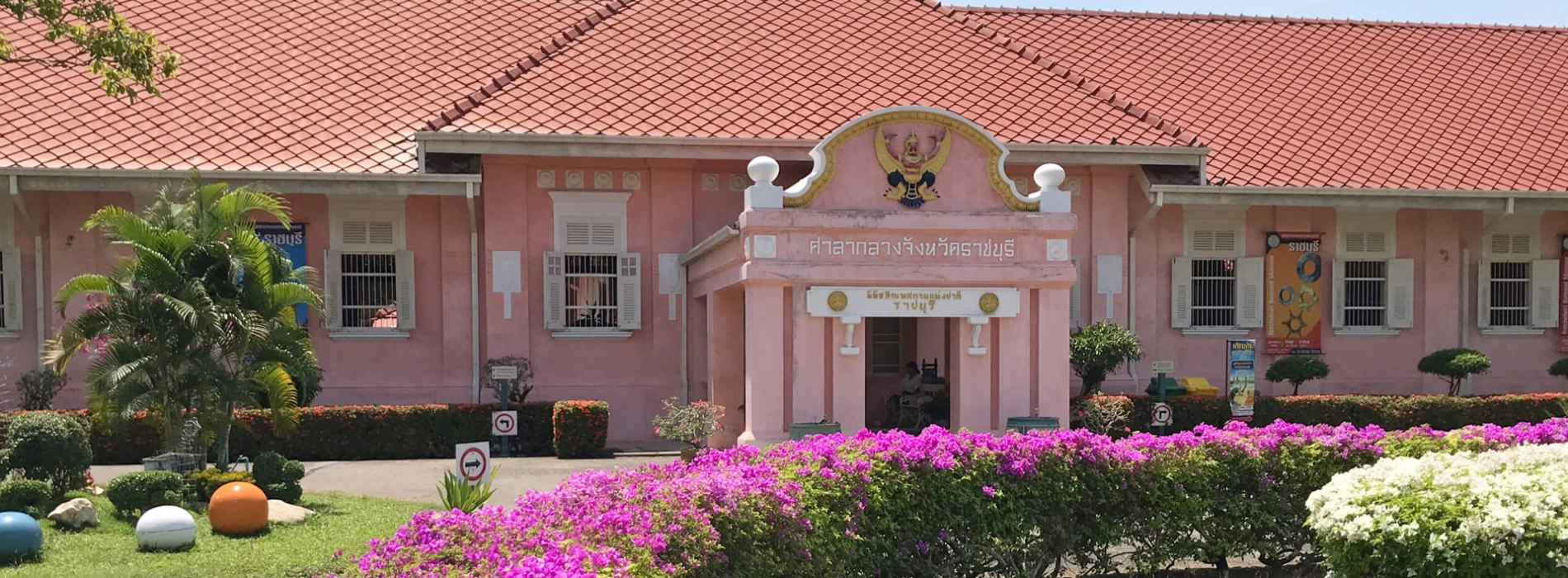Ratchaburi National Museum

Ratchaburi National Museum is a cultural institution located in Ratchaburi, Thailand that plays an important role in preserving and presenting the rich history and culture of the area. It is an important cultural resource for education and culture, which provides a comprehensive overview of the historical and cultural fabric of the province to its visitors. The museum has a significant role to play in conserving and promoting Ratchaburi’s rich heritage through its well-arranged displays and interesting activities.
Let’s explore this museum with Asia King Travel!
The Ratchaburi National Museum is situated near the clock tower along the Mae Klong River, Woradet Road, Na Mueang Sub-district, Mueang District, Ratchaburi Province. It was established on 20 November 1986.

History of Ratchaburi National Museum
The Fine Arts Department has sought permission to use the original Ratchaburi City Hall building constructed in 1922 during the reign of King Rama IV as a museum in its project to establish a national museum of the Fine Arts Department. Princess Maha Chakri Sirindhorn opened Ratchaburi National Museum in 1991.

History of Ratchaburi National Museum
Visitors and interested persons can view exhibitions on Ratchaburi history, archaeology, ethnology, geology, folk art, traditional fishing method and ethnic groups culture such as Tai dam, Karen, Tai Yuan and various tourist attractions in Ratchaburi Province; rare antiques like royal sword of Ratchaburi; Bodhisattva Avalokiteshvara Khmer style of Bayon which is one of five buddhist statue of Thailand that found in perfect condition.
The Ratchaburi National Museum is located in a historical building that represents early 20th-century Thai architecture, which combines traditional Thai and Western styles. The following are some of the architectural features of the museum:
.jpg)
Architecture of Ratchaburi National Museum

Architecture of Ratchaburi National Museum
The architecture of Ratchaburi National Museum is important not only for its aesthetic value or historical significance but also because it embodies much of Thailand’s architectural heritage characterized by cultural fusion. It stands as a testament to the region’s history while providing an appropriate setting for housing rich collections within a museum.
Visitors can enjoy both what is inside the museum as well as appreciate how beautiful it looks architecturally thereby making it a complete cultural experience.
Read more: Thailand Tours 20 days
While visiting the Ratchaburi National Museum, there are various activities and exhibits to explore that provide a rich cultural and educational experience. In the Prehistoric Artifacts section, you can find tools, pottery, and ornaments from early human settlements in Ratchaburi.
.jpg)
What does the Ratchaburi National Museum have?
In the Dvaravati Period Artifacts section, there are stone sculptures, inscriptions, and religious objects from the 6th to 11th centuries. The Ethnographic Displays will teach you about traditional costumes of different ethnic groups in the region as well as household items and musical instruments.
.jpg)
What does the Ratchaburi National Museum have?
The Local History Exhibits trace Ratchaburi’s development from ancient times to the modern era. Finally, Ceramics Collection showcases traditional and contemporary pottery that highlights local craftsmanship and artistic traditions.
The Ratchaburi National Museum is closed on Mondays and Tuesdays. On all other days, it's open from 9 a.m. until 4 p.m. The museum has dual pricing, with Thai citizens paying 20 Baht for admission and foreigners paying 100 (~$3 USD).
The Ratchaburi National Museum is best visited during the cooler, dry season from November to February. The weather in Ratchaburi is more pleasant and comfortable for sightseeing during this period, with lower temperatures and minimal rainfall. By visiting at this time of year, you can explore the museum and its environs without having to endure extreme heat or humidity.

Best time to visit Ratchaburi National Museum
The Ratchaburi National Museum is ideally placed in the middle of Ratchaburi town and is easily accessible by numerous forms of transportation. The museum is located around 100 kilometers southwest of Bangkok on Highway 4 (Phetkasem Road). The trip takes around 1.5 to 2 hours, and parking is frequently accessible.
By train: Regular trains travel from Bangkok's Hua Lamphong Railway Station to Ratchaburi, taking around 2 to 2.5 hours. The museum is a short taxi or tuk-tuk ride (or 15-minute walk) from Ratchaburi Railway Station.
By bus or minivan: Buses and minivans travel from Bangkok's Southern Bus Terminal (Sai Tai Mai) toward Ratchaburi, which takes around 2 hours. You may get to the museum via taxi or tuk-tuk from the Ratchaburi Bus Terminal.
Local Transportation: Taxis, tuk-tuks, and motorbike taxis are easily accessible throughout Ratchaburi. Most drivers are aware of the museum's location. If you stay in the town center, the museum is also within walking distance, allowing you to explore the surrounding region on foot.
Read more: Center Thailand tours